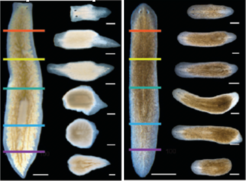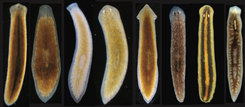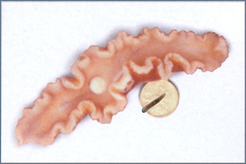Species Comparisons

Differences in regenerative abilities between planarian species: While Dendrocoelum lacteum (left) cannot regenerate new heads at cuts in the posterior body half, the model species Schmidtea mediterranea (right) can.
Laboratory model organisms provide the necessary depth for the elucidation of molecular mechanisms but at the price of blanking out the sheer breadth of animal diversity and environmental interactions that gave rise to it. This means that model organisms are great for understanding how phenotypes arise, but not why. We aim to reconcile the two by establishing molecular mechanisms in the planarian model species S. mediterranea, to then ask how they change between species as to bring about the fascinating diversity in the hundreds of planarian species worldwide.

To this end, we maintain and keep expanding a unique live collection of >50 planarian species in the department. Already the current collection covers a broad range of regenerative abilities from the whole-body regeneration of the model species to partial regeneration defects or no regeneration at all. So far, our work with “wild” planarians has established the Wnt signaling pathway as both cause and a cure of a species-specific regeneration defect D. lacteum (Liu, Selck et al. 2013). Further, we could show that independently evolved head regeneration defects elsewhere in planarian phylogeny can similarly be bypassed by Wnt inhibition (M. Vila-Farré, unpublished). Current projects explore a pleiotropic role of Wnt signaling in the reproductive system, which could link the evolutionary dynamics of planarian regeneration to the two planarian reproduction modes (i.e., regeneration-requiring asexual reproduction by fission versus regeneration-independent sexual reproduction). In addition, we are probing the gene regulatory changes associated with regeneration altering changes in Wnt signaling as an experimental inroad to a mechanistic understanding of regeneration defects.
Questions we are interested in

One of the giant planarians of Lake Baikal- a medium-sized S. mediterranea has been photoshopped onto the coin to illustrate the massive size difference between the species. Image courtesy of Prof. Oleg Timoshkin.
Besides regeneration, our species collection reflects an intriguing diversity of body size & shape, sexual vs. asexual reproduction modes, environmental adaptations (e.g., freshwater versus marine) or, likely, also life span variations from a few months to a complete lack of aging. The ready availability of experimental animals, our available transcriptome and genome resources and the general technical expertise of the department amount to exciting opportunities for pioneering genotype/phenotype links within the collection. For example,
- What is the mechanistic basis of the observed growth/de-growth rate variations?
- What mediates life span determination in planarians and what allows asexual strains to apparently escape aging?
- Why are asexual reproduction strategies so common in planarians?
- How is body size encoded in the planarian genome?
- What are the anatomical and molecular adaptations associated with the evolutionary transition from water to land?


